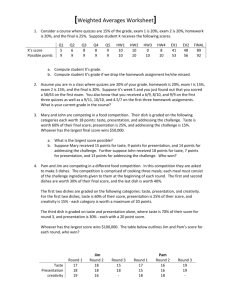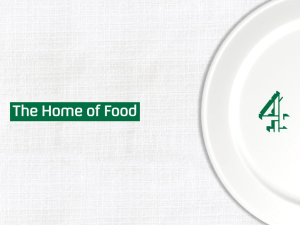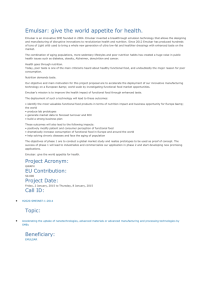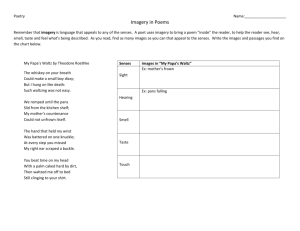Religious Taste - Universität Bielefeld
advertisement
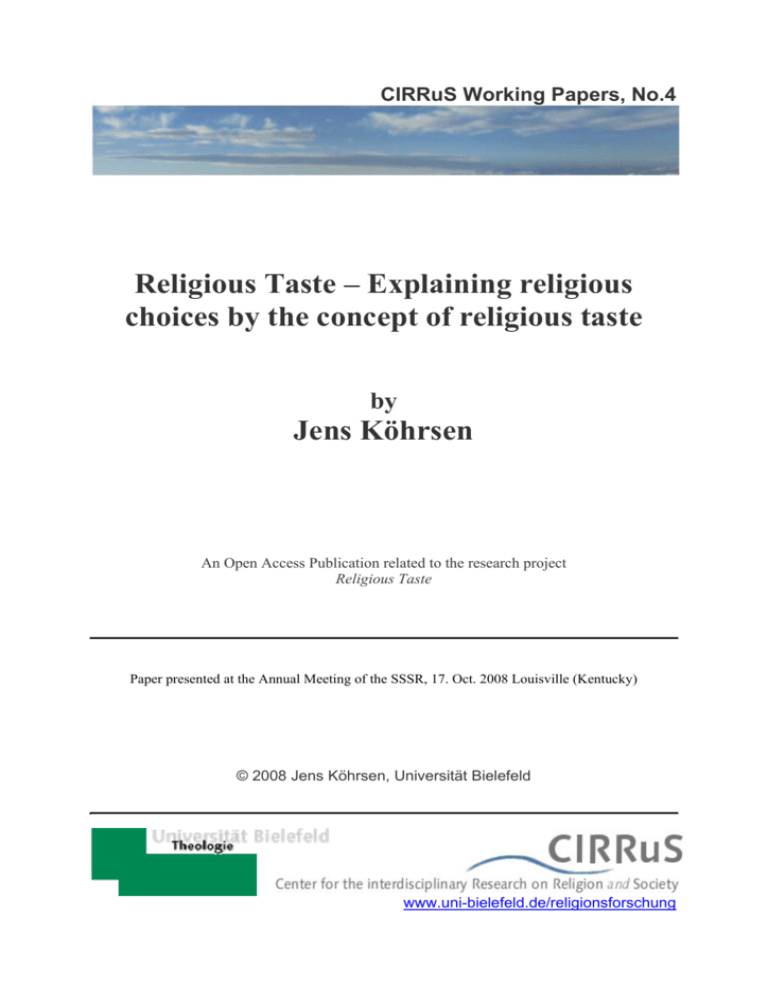
CIRRuS Working Papers, No.4 Religious Taste – Explaining religious choices by the concept of religious taste by Jens Köhrsen An Open Access Publication related to the research project Religious Taste Paper presented at the Annual Meeting of the SSSR, 17. Oct. 2008 Louisville (Kentucky) © 2008 Jens Köhrsen, Universität Bielefeld www.uni-bielefeld.de/religionsforschung Summary This lecture presents a short overview of the concept of religious taste and how it can contribute to an understanding of religious choices. The core question is: How can religious choices be explained? The concept of taste taken from the social theory of the French sociologist Pierre Bourdieu and applied to the field of religion is assumed to contribute to an explanation of religious choices. Introduction Today we can observe a growing religious plurality. In societies of religious freedom and plurality individuals are free to choose to be Zen-Buddhists, Shiite-Muslims, Pentecostal Christians, Hindus, charismatic Catholics etc. or to consider themselves as atheists. As the religious market pluralizes it is becoming more and more normal to choose religious practices and beliefs whereas staying in the inherited religious group is becoming unusual or an exceptional case as Peter L. Berger pointed out earlier. People are increasingly choosing their own religious forms of expression and beliefs. If this is the case it is crucial for the understanding of the dynamics of modern religious markets (fields) to explain how individuals choose their religious forms of expression in the process of religious choice. Therefore the central questions of this lecture are: How do individuals choose religious “products”? Which variables exert influence on religious choices? 1 Defining religious choice What does the term religious choice mean? A religious choice is any decision that an individual makes with respect to his religious practice. Religious choices can be for example every-day-choices like when and how one prays (if this is not established in the individual’s routine) or extraordinary choices like the decision to convert from Christianity to Islam. For our purpose we reduce the term “religious choice” to the selection of a religious congregation: A religious choice is the decision to affiliate with a particular religious group (church). An example for a religious choice in the defined sense is the switching from one Pentecostal church to another or the switching from a Baptist church to a particular Methodist church. Any time an individual chooses to affiliate with a particular congregation, he is making a religious choice: He chooses a particular congregation and decides against all other (known) alternatives. In terms of religious-market-language the religious choice would be the decision for a certain religious product. This religious product has a particular style. Accordingly the choice to affiliate with a particular religious group includes the choice of a religious style. Religious taste and religious choice Which factors drive individuals to affiliate with a particular religious congregation? Many factors can certainly be found that have an influence on the choice of a religious congregation. But, one is considered to be most crucial: the religious taste. The term “taste” comes from the sociology of Pierre Bourdieu who used it to explain the correlation between the consumption of particular cultural products and social classes in the French society. Applied to the field of religion this term can contribute to an explanation of religious choice. We define the term “religious taste” in the following way: The religious taste is the individual‘s system of preferences that guides the formation of his/her judgments in the field of religion. 1 Although market terms are applied, the concept presented here is not based on the premise that the dynamics of religious fields are reducible to the idea of (economic) markets where individuals try to maximize their benefits. Rather its purpose is to develop a different model that tries to overcome the limits of Rational Choice Theory. Based on their taste people will form judgments about different religious products. They can say which types of religious style they like and which types they dislike. Individuals will judge different religious products as good or bad, tasteful or tasteless, fake or real etc. An example of a religious taste would be a preference for ascetic religious practice and an aversion to prosperity gospel. Religious taste is not static. The preferences and judgments of taste can change throughout the course of time. Religious taste has a major influence on how an individual perceives and experiences different types of religious practice. Due to its function as a pattern of perception and judgment, religious taste will shape religious choices. Assuming that religious taste guides religious choice we can suppose: An individual will seek a fit between his/her individual religious taste and the religious style of his (future) congregation. One can draw two conclusions from this assumption: 1) An individual will be more likely to affiliate with a religious congregation if he/she experiences a fit between his individual religious taste and the religious style of this congregation 2) An individual will tend to leave his religious congregation when she/he does not experience a good fit between her/his individual religious taste and the religious style of the religious congregation. In case of switching their religious congregation individuals will seek a better fit between their religious taste and the religious style of the (future) congregation. Factors that influence religious taste If religious taste has an influence on religious choice then it is decisive to explain which variables form the taste. The sociology of Pierre Bourdieu shows that cultural tastes are influenced by the social position and the upbringing of an actor. The taste of a person is nothing naturally inherited but rather socially inherited. The current social environment of an individual will have an impact on his religious preferences. In terms of Bourdieu’s sociology the current social environment is basically determined by his position in the social hierarchy. This position is defined by the composition of three types of capital (or resources): economic capital, cultural capital (education) and social capital. Every social position corresponds with a set of cultural norms and tastes. Therefore people in different social positions (with different educational, economic, social resources) tend to consume different cultural products. If we reduce these social positions to the simpler idea of social classes and apply it to the field of religion, then we can say that social classes will differ in their religious tastes and religious consumption whenever they choose religious products. Higher social classes will try to differentiate their religious consumption from that of lower social classes. Yet, the picture drawn here is rather simplistic; one can find other factors involved in shaping the religious taste of an individual besides the bare social position. Unfortunately the sociology of Bourdieu does not point out that individuals move in subcultures that are not completely determined by there social position. These subcultures tend to influence preference-structures and will also play an important role in shaping the religious taste. But besides pointing out the current social position as an important factor Bourdieu gives us another clue for understanding the formation of religious taste: the upbringing of an individual. The social position experienced during childhood shape the taste of an individual. Besides the general socialization, the religious socialization will play an essential role in determining religious tastes. The socialization is a life long process that doesn’t stop at childhood. So it is not only the early religious education that one receives in childhood; later membership in religious organizations will influence the religious taste as well. Finally, there are religious markets that have an impact on religious tastes through fashion cycles. 2 The religious market consists of different producers of religious goods that compete with each other for the sympathies of particular market segments (groups of religious consumers). The power struggles in the market generate a proper dynamic and create fashion cycles. A fashion cycle defines what is seen as “in” and what is seen as “out” for particular groups of consumers. In the case of religion, fashion cycles define which types of practice (styles) are religiously legitimate and fashionable for certain social groups and which are not. 3 In a particular moment we can always observe religious producers exerting more influence on what is seen as the proper style for certain social groups than other producers of religious goods in a religious market. The less powerful religious producers compete with these powerful and established producers for what is the legitimate religious style and try to take over the power. 4 An Overview Resuming these ideas, the most influential factors shaping the religious taste of an individual would be: o Current social class position defined by the composition of economic, cultural and social capital. o Current subculture of an individual o Upbringing in a particular social environment o Religious socialization o Religious markets and its fashion cycles. None of these factors alone will shape the religious taste rather the taste is a function of the interrelation between these (and more) factors. Returning to the primary question of how religious choices are made today, we can draw the following diagram to explain religious choices: 2 The term „religious market” applied here corresponds to Bourdieu’s concept of field. The social groups often correspond to the concept of social positions and subcultures. Fashion cycles define fashionable and proper religious styles for particular social positions and subcultures 4 For example, in Argentinean Pentecostalism of the 80s and early 90s Pastor Gimenez was the most popular figure. He had a strong impact on Pentecostalism in Argentina and even the Pentecostalism of the surrounding countries. In this time he shaped the practice of Pentecostalism and was in the position to define for many Pentecostals what the real essence of Pentecostalism was. In the 90s scandals arose around his person which led to his downfall. Today he still works as a pastor but his influence has shrunk significantly. Due to the scandals he has the reputation of being a fake pastor, who cheats and defrauds his followers in the Argentinean public. Today other suppliers of Pentecostalism like Pastor Freidson with his church “Rey de Reyes” determine the “haute couture” of Pentecostalism and shape the religious tastes of Pentecostal consumers. 3 The variable to be explained is the religious choice. Therefore the concept of religious taste is introduced. Religious taste as an individual’s system of religions preferences is assumed to shape religious choices. Again, the taste depends on different variables that can be basically reduced to three important factors: socialization (upbringing and religious socialization), social position and subculture of an individual and the religious markets (fashion cycles). Yet, the religious taste is certainly not the only factor determining religious choices. The religious market does not only influence the religious choice indirectly through the religious taste but also directly. Some producers of religious goods know how to better attract religious consumers than others due to their marketing skills, their visibility to the public eye and their strategies of integrating new members. But again, a religious individual wouldn’t stay in a congregation if he doesn’t experience a fit between its religious style and his religious taste. Hence the religious choice is rather a product of the interaction between taste and market. Finally, there are also several contingent factors involved in religious choices, for example the limited information about religious options, coincidence etc. Conclusion In late modernity, inherited commitments to religious congregation increasingly lose their strength and the religious individual becomes a consumer of religious goods. The “consumer” searches for, compares and selects products according to his taste. It is mainly his preference structure, the taste, that guides his religious consumption when the links to inherited religion are cut. This preference structure is not detached from the social structure that surrounds the individual. The taste of an individual is either naturally inherited or pure coincidence. The sociology of Pierre Bourdieu helps in the understanding that taste is largely a function of the social environment (social position) and biography of an individual. Connecting the individual religious choice by the concept of taste to the social structure fills the gap between micro-social models - which focus only on the individual and his/hers contingent biography - and macro-social models to explain in which way social structures and individual religious choices are interrelated. Seldom religious consumption is fully determined by religious taste. Religious taste is merely an affinity for particular religious styles. The final choice to affiliate with a particular religious congregation is a product of a complex interaction between different variables in which religious taste plays a central role. Due to the complexity of religious choice it is impossible to develop a sociological model that provides a full explanation of every particular case. Nevertheless the concept of religious taste can explain the affinity of particular social groups to certain types of religious products. 5 Bibliography: Berger; Peter L. (1979) The Heretical Imperative, New York. Bourdieu, Pierre (1984) Distinction: a Social Critique of the Judgment of Taste, Harvard University Press (1996) Rules of Art: Genesis and Structure of the Literary Field, Stanford University Press. (2000) Das religiöse Feld. Texte zur ökonomie des Heilsgeschehens, UVK Verlags GmbH. 5 An example would be the affinity of lower social classes to Pentecostalism that we can observe in Latin-American countries like Argentina. Higher social classes generally do not affiliate with the Pentecostal congregations. They try to differentiate in their religious tastes and religious styles from lower social classes. In the rare case of attracting individuals from higher social classes, Pentecostalism changes its appearance. Pentecostal congregations that attract higher social classes differ from “mainline”-Pentecostalism. While other theories try to trace the affinity of lower social classes to Pentecostalism back to their social needs, the concept of taste can contribute to a more complex explanation of this relation.



